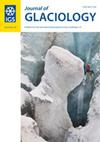利用放射性标记粒子追踪高山冰下通道中的粗沉积物
IF 2.6
3区 地球科学
Q2 GEOGRAPHY, PHYSICAL
引用次数: 0
摘要
摘要:我们提出了一种追踪温带浅冰川下冰下融水通道中放射性标记鹅卵石和鹅卵石的方法。标记有主动无线电发射机的天然粒子被直接注入从瑞士奥德马冰川末端冰川上方300米的大型冰下通道。研究人员开发了一种漫游天线,利用概率技术在冰下和冰前通道(分别为350米和150米长)中平面定位标记粒子,记录粒子位置和传输距离随时间的不确定性变化。粗纱天线的平面精度为±5 - 15 m,粒子定位率为75%,最大冰深为47 m。此外,静止的冰川上和冰川前天线持续监测标记粒子在通道连续到达的通道,限制了粒子输运事件的时间。前冰川天线系统的检出率为98.1%,测试时工作水深为0.89 m。将漫游和固定天线记录结合起来,创建每个粒子的传输距离模型,该模型可以与水力数据结合使用,以研究粒子运动的运动学。在未来的研究中,该方法可用于揭示高山冰川粗沙输出的机制和时间尺度。本文章由计算机程序翻译,如有差异,请以英文原文为准。
Tracking coarse sediment in an Alpine subglacial channel using radio-tagged particles
Abstract We present a method for tracking radio-tagged pebbles and cobbles through subglacial meltwater channels under shallow temperate glaciers. Natural particles tagged with active radio transmitters were injected directly into a large subglacial channel 300 m up-glacier from the terminus of the Glacier d'Otemma, Switzerland. A roving antenna was developed to localise tagged particles planimetrically in subglacial and proglacial channel reaches (350 and 150 m long, respectively) using a probabilistic technique, delivering records of the change in particle location and transport distance over time with uncertainty. The roving antenna had a ±5−15 m planimetric precision, a 75% particle localisation rate and operated at a maximum ice depth of 47 m. Additionally, stationary supraglacial and proglacial antennas continuously monitored the passage of tagged particles through consecutive reaches of the channel, constraining the timing of particle transport events. The proglacial antenna system had a 98.1% detection rate and was operational to 0.89 m water depth during testing. Roving and stationary antenna records were combined to create a transport distance model for each particle, which may be used in conjunction with hydraulic data to investigate the kinematics of particle motion. When applied at scale in future studies, this method may be used to reveal the mechanisms and timescales of coarse sediment export from Alpine glaciers.
求助全文
通过发布文献求助,成功后即可免费获取论文全文。
去求助
来源期刊

Journal of Glaciology
地学-地球科学综合
CiteScore
5.80
自引率
14.70%
发文量
101
审稿时长
6 months
期刊介绍:
Journal of Glaciology publishes original scientific articles and letters in any aspect of glaciology- the study of ice. Studies of natural, artificial, and extraterrestrial ice and snow, as well as interactions between ice, snow and the atmospheric, oceanic and subglacial environment are all eligible. They may be based on field work, remote sensing, laboratory investigations, theoretical analysis or numerical modelling, or may report on newly developed glaciological instruments. Subjects covered recently in the Journal have included palaeoclimatology and the chemistry of the atmosphere as revealed in ice cores; theoretical and applied physics and chemistry of ice; the dynamics of glaciers and ice sheets, and changes in their extent and mass under climatic forcing; glacier energy balances at all scales; glacial landforms, and glaciers as geomorphic agents; snow science in all its aspects; ice as a host for surface and subglacial ecosystems; sea ice, icebergs and lake ice; and avalanche dynamics and other glacial hazards to human activity. Studies of permafrost and of ice in the Earth’s atmosphere are also within the domain of the Journal, as are interdisciplinary applications to engineering, biological, and social sciences, and studies in the history of glaciology.
 求助内容:
求助内容: 应助结果提醒方式:
应助结果提醒方式:


